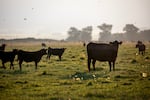Oregon State University researchers want to find a way to make your hamburger less bad for the planet by feeding cows in the pasture an unlikely food that’s not grown on land — seaweed.
From feed production, to slaughter and transportation to grocery stores, beef can have a major impact on the climate.
There are about 1.2 million beef and dairy cattle, including calves, in Oregon. Those animals can digest tough fibers like grass, hay or corn silage, but during the process, they produce methane, which is then released into the atmosphere in the form of a burp.
“And they actually burp a lot, like, multiple times in a minute,” said Juliana Ranches, an assistant professor at Oregon State’s Eastern Oregon Agricultural Research Center. “That’s actually how we measure methane from cows.”

FILE - Cows in a field along Highway 30, just south of Baker City, Ore., July 30, 2024.
Anna Lueck / OPB
Methane is a greenhouse gas emission. It’s more than 28 times as potent as carbon dioxide at trapping heat in the planet’s atmosphere. Cattle are at the top of the list for agricultural sources of greenhouse gasses in the U.S. In a single year, a cow can belch out over 200 pounds of methane.
With the growing effects of climate change, and a future where it’s unlikely everyone will become vegan or cut beef out of their diets completely, scientists are looking at solutions to reduce emissions, specifically from cattle.
Enter seaweed as feed for cattle. Studies have shown seaweed contains a compound, bromoform, that if fed in small amounts everyday to cattle, can cut the production of methane by 82%. But most of those studies have focused on dairy cattle, who are usually fed by humans.
Ranches and her team will study a specific type of seaweed, Pacific dulse — a species grown commercially on the Oregon Coast — and focus on cattle that graze on sagebrush steppe landscapes, similar to where most beef cattle graze in Eastern Oregon and much of the western United States.
“Most of the research on seaweed feed supplementation for cattle has taken place in feedlots,” said Rory O’Connor, a rangeland ecologist with the U.S. Department of Agriculture and co-director of the project. “Our work is novel because we are focused on cattle that graze in the sagebrush-steppe ecosystem.”
Ranches said the idea is to find a way to feed the cows on the pasture the seaweed.
“Our final and major goal is to be able to come up with some strategy for producers,” Ranches said. “[To say] ‘hey, here’s the seaweed. It really works, you need to feed it this amount. Here’s how we’re going to suggest you feed it.’”
For the project, about 20 cows will graze each year in an approximately 100-acre pasture near Riley, west of Burns in Oregon’s Harney County. Ranches said they will feed the cows varying amounts of the seaweed and then measure the amount of methane released where the cows would be grazing using a set of towers that can track the gasses.
“We’re also going to be evaluating soil carbon. So how much of the carbon that those animals are emitting is being incorporated in the soil,” Ranches said. “Because we know rangelands are known to be a carbon sink.”
Ranches said it’s unlikely producers will adopt the use of seaweed into their cows’ diet, but at least figuring out whether their research can work is a start.
“With livestock production it’s probably impossible,” she said. “But what I think it’s really interesting for us is when you think about that pressure [to reduce greenhouse gas emissions from agriculture], of course, we need to do our part.”
The project will last for five years. It’s funded by the U.S. Department of Agriculture National Institute of Food and Agriculture.



